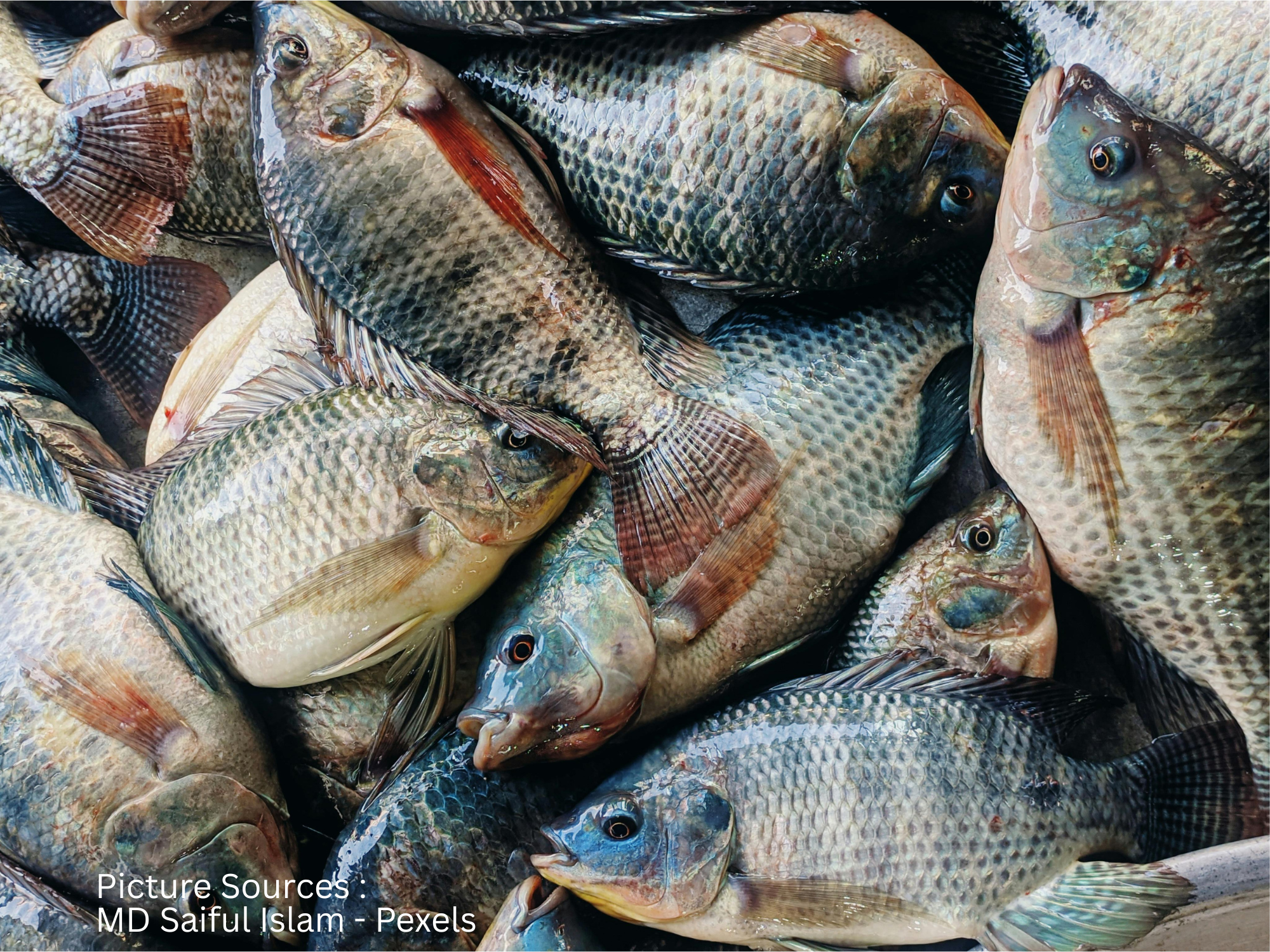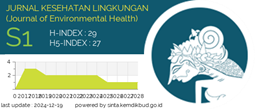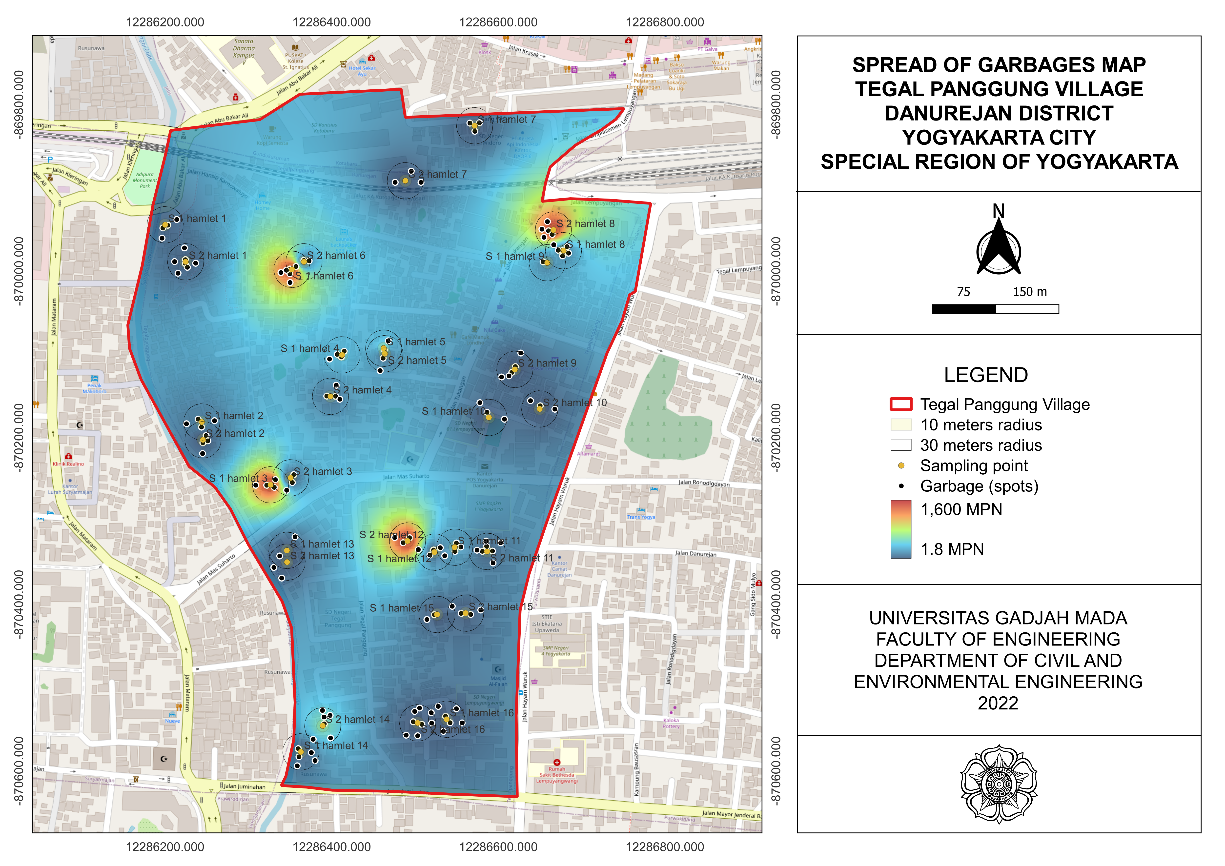Microplastics in Oreochromis Niloticus: An Abundance Study and Health Risk Assessment Around the Gajah Mungkur Reservoir

Introduction: More than 430 million tons of plastic waste are added globally each year, increasing the potential distribution of microplastics, particularly in aquatic environments. Microplastic contamination in the Gajah Mungkur Reservoir is thought to come from nearby textile factories and fish farming using plastic floating nets. This study differs from previous research that only identified microplastics in reservoir water by conducting an individual-based carcinogenic health risk assessment using primary data. This study aims to identify the characteristics of microplastics in Oreochromis niloticus (abundance of particle, shape, color, and polymer type) and assess the carcinogenic risks of the local community. Methods: This quantitative descriptive research used 9 Oreochromis niloticus samples from floating net cages and 30 respondents selected through purposive sampling techniques. Microplastics were identified using a stereomicroscope and FTIR. The Microplastic Carcinogenic Risk (MPCR) formula was applied. The research ran from November 2024 to March 2025. Results and Discussion: Microplastics in Oreochromis niloticus had an average abundance of 0.45 particles/gram, with the highest at 0.87 particles/gram. The estimated daily intake of microplastic particles in respondents shows an average result of 0.007730 particles/day. The average MPCR value of respondents is 1.86×10-6, indicating a carcinogenic risk level according to US EPA guidelines, although still within tolerable limits. Conclusion: The average respondent is at risk of carcinogenic microplastics but still within tolerance limits. Suggestions for the community are not to throw garbage and household waste into the rivers around the reservoir and to reduce single-use plastics.
UNEP. United Nations Environment Programme (UNEP). 2023. Microplastics: The Long Legacy Left Behind by Plastic Pollution. https://www.unep.org/news-and-stories/story/microplastics-long-legacy-left-behind-plastic-pollution
Seftianingrum B, Hidayati I, Zummah A. Identifikasi Mikroplastik pada Air, Sedimen, dan Ikan Nila (Oreochromis niloticus) di Sungai Porong, Kabupaten Sidoarjo, Jawa Timur. J Jeumpa. 2023;10(1):68–82. https://doi.org/10.33059/jj.v10i1.7408
Yusron M, Asroul JM. Analisis Jenis dan Kelimpahan Mikroplastik serta Pencemaran Logam Berat pada Hulu Sungai Bengawan Solo. Environ Pollut J. 2021;1(1):41–8. https://doi.org/10.58954/epj.v1i1.6
Osman AI, Hosny M, Eltaweil AS, Omar S, Elgarahy AM, Farghali M. Microplastic Sources, Formation, Toxicity and Remediation: A Review. Environ Chem Lett. 2023;21(4):2129–2169. https://doi.org/10.1007/s10311-023-01593-3
Alberghini L, Truant A, Santonicola S, Colavita G, Giaccone V. Microplastics in Fish and Fishery Products and Risks for Human Health: A Review. Int J Environ Res Public Health. 2023;20(1):789-796. https://doi.org/10.3390/ijerph20010789
Supit A, Tompodung L, Kumaat S. Mikroplastik sebagai Kontaminan Anyar dan Efek Toksiknya terhadap Kesehatan. J Kesehatan. 2022;13:199–208. https://doi.org/10.26630/jk.v13i1.2511
Leslie HA, Velzen MJM, Brandsma SH, Vethaak AD, Garcia-Vallejo JJ, Lamoree MH. Discovery and Quantification of Plastic Particle Pollution in Human Blood. Environment International . 2022;163(1): 1-8. https://doi.org/10.1016/j.envint.2022.107199
Ragusa A, Svelato A, Santacroce C, Catalano P, Notarstefano V, Carnevali O. Plasticenta: First Evidence of Microplastics in Human Placenta. Environ. 2021;146(1):1-8. https://doi.org/10.1016/j.envint.2020.106274
Budiarti EC. Identifikasi Mikroplastik pada Feses Manusia. Environ Pollut J. 2021;1(2):84–100. https://doi.org/10.58954/epj.v1i2.11
Anjani D, Rafi A. Kandungan Mikroplastik pada Saluran Pencernaan Ikan Kerapu Muara (Epinephelus Coioides) di Perairan Pangempang Kecamatan Muara Badak. Trop Aquat Sci. 2023;2(2):183–190. https://doi.org/10.30872/tas.v2i2.742
Chen Y, Chen Q, Zhang Q, Zuo C, Shi H. An Overview of Chemical Additives on (Micro)PlasticFibers: Occurrence, Release, and Health Risks. Rev Environ Contam Toxicol. 2022;260(1):1–25. https://doi.org/10.1007/s44169-022-00023-9
Kurniawidjaja LM, Lestari F, Tejamaya M, Ramdhan DH. Konsep Dasar Toksikologi Industri. 1st ed. Fakultas Kesehatan Masyarakat Universitas Indonesia. Depok: Fakultas Kesehatan Masyarakat Universitas Indeonesia; 2021. 1–181. https://fkm.ui.ac.id/wp-content/uploads/2024/08/Buku_Toksikologi_Industri.pdf
Jawa Tengah Destination. Jawa Tengah Destination. Waduk Gajah Mungkur: Lepaskan Pandang Matamu Sejauh Mungkin. 2023. https://jawatengahdestination.com/place/waduk-gajah-mungkur
Diskominfo Kabupaten Wonogiri. Publikasi Statistik Data Sektoral Bidang Perikanan Tahun 2021. 1st ed. Dinas Komunikasi dan Informasi Kabupaten Wonogiri, editor. Wonogiri: Dinas Komunikasi dan Informasi Kabupaten Wonogiri; 2021. https://datasektoral.wonogirikab.go.id/assets/publikasi/file/file-cdc978e957-Daftar_isi_dan_halaman_fiks.pdf
Pemerintah Desa Sendang. Pemerintah Desa Sendang. Karamba Jala Apung (KJA) Waduk Gajah Mungkur-Potensi Perikanan Desa Sendang. 2018. https://www.sendang-wonogiri.id/artikel.php?id=617
Santoso RB, Yulistyorini A, Rahayuningsih T. Analysis of Microplastic Content in Surface Water of the Gajah Mungkur Reservoir in Indonesia Analysis of Microplastic Content in Surface Water of the Gajah Mungkur Reservoir in Indonesia. IOP Conf Ser Earth Environ Sci. 2025;1453(1): 1-9. https://doi.org/10.1088/1755-1315/1453/1/012056
Aprilianti R. Panduan Uji Mikroplastik Laboratorium ECOTON. 1st ed. Aprilianti R, editor. Gersik: ECOTON (Ecological Observation and Wetland Conservations); 2024. 1–11. https://ecoton.or.id/wp-content/uploads/2024/03/Panduan-Citizen-Science-1.pdf
Gunawan G, Effendi H, Warsiki E. Cemaran Mikroplastik pada Ikan Pindang dan Potensi Bahayanya terhadap Kesehatan Manusia, Studi Kasus di Bogor. J Pascapanen dan Bioteknologi Kelautan dan Perikanan. 2021;16(2):105-119. http://dx.doi.org/10.15578/jpbkp.v16i2.772
Dirjen P2PL. Pedoman Analisis Risiko Kesehatan Lingkungan (Guidance on Environmental Health Risk Analysis). P2PL D, editor. Jakarta: Kementerian Kesehatan Republik Indonesia; 2012. 1–82. https://www.scribd.com/doc/289323635/Pedoman-ARKL-1
Enyoh CE, Wang Q, Rabin MH, Bakare RO, Dadiel JL, Shangrong W. Preliminary Characterization and Probabilistic Risk Assessment of Microplastics and Potentially Toxic Elements (PTEs) in Garri (Cassava Flake), A Common Staple Food Consumed in West Africa. Environ Anal Heal Toxicol. 2023;38(1):24. https://doi.org/10.5620/eaht.2023005
US EPA. Recommended Use of Body Weight 3/4 as the Default Method in Derivation of the Oral Reference Dose. Washington DC; 2011. https://www.epa.gov/risk/recommended-use-body-weight-34-default-method-derivation-oral-reference-dose
USEPA. Health Effects Assessment Summary Tables. Vol. 1. Washington DC: United States Environmental Protection Agency; 1992. https://thesis.ekt.gr/thesisBookReader/id/1834#page/104/mode/2up
Salamone JC. Polymeric Materials Encyclopedia. Contemporary Physics. 1996; 9(1): 6036–6047. https://journals.sagepub.com/doi/10.1177/147823919600400209
Wicaksono EA. Threats of Microplastic Pollution on Aquaculture Activities in Indonesia. Torani J Fish Mar Sci. 2022;5(2):77–91. https://doi.org/10.35911/torani.v5i2.20106
Handayani TA, Nurfitriniha WS, Fuziyanti A, Rizkika V, Ismayati I. Karakteristik Morfologi Ikan Nila (Oreochromis niloticus) pada Pengelolaan Budidaya Ikan di Kampung Buah Jakung Kabupaten Serang. JB&P J Biol dan Pembelajarannya. 2024;11(1):29–36. https://ojs.unpkediri.ac.id/index.php/biologi
Zhou A, Zhang Y, Xie S, Chen Y, Li X, Wang J. Microplastics and Their Potential Effects on The Aquaculture Systems: A Critical Review. Rev Aquac. 2021;13(1):719–733. https://doi.org/10.1111/raq.12496.
Talbot R, Chang H. Microplastics in Freshwater: A Global Review of Factors Affecting Spatial and Temporal Variations. Environ Pollut. 2022;292(1):1-11. https://doi.org/10.1016/j.envpol.2021.118393
Yu Q, Hu X, Yang B, Zhang G, Wang J, Ling W. Distribution, Abundance and Risks of Microplastics in The Environment. Chemosphere. 2020;249(1):1-12. https://doi.org/10.1016/j.chemosphere.2020.126059
Wisnu S, Dyah A. Kajian Kelimpahan Mikroplastik di Biota Perairan. J Ilmu Lingkung. 2021;19(3):638–648. https://doi.org/10.14710/jil.19.3.638-648
Wienardy AE, Fitriyah F, Syarifah U. Identifikasi Tipe dan Kelimpahan Mikroplastik pada Ikan Nila (Oreochromis Niloticus) di Waduk Lahor Kabupaten Malang Jawa Timur. Biol Nat Resour J. 2023;2(2):68–74. https://dx.doi.org/10.55719/binar.v2i2.693
Euro P. Polypropylene vs. Polyurethane: What are the differences?. Hanoi: EuP Group. 2025. https://europlas.com.vn/en-US/blog-1/polypropylene-vs-polyurethane-what-are-the-differences
Garg H, Mohanty J, Gupta P, Das A, Tripathi BP, Kumar B. Polyethylenimine-Based Shape Memory Polyurethane with Low Transition Temperature and Excellent Memory Performance. Macromol Mater Eng. 2020;305(8):1–13. http://doi.org/10.1002/mame.202000215
Mar’ie M, Saifullah, Istiqamah N. Faktor-faktor yang Mempengaruhi Tingkat Konsumsi Ikan pada Masyarakat di Kecamatan Sajad. Nekt J Perikan dan Ilmu Kelaut. 2022;2(1):27–34. https://doi.org/10.47767/nekton.v2i1.323
Garrido Gamarro E, Ryder J, Elvevoll EO, Olsen RL. Microplastics in Fish and Shellfish–A Threat to Seafood Safety?. J Aquat Food Prod Technol. 2020;29(4):417–425. https://doi.org/10.1080/10498850.2020.1739793
Esposito G, Prearo M, Renzi M, Anselmi S, Cesarani A, Barcelò D. Occurrence of Microplastics in The Gastrointestinal Tract of Benthic by-catches from an Eastern Mediterranean Deep-sea Environment. Mar Pollut Bull. 2022;174(1): 1-9. https://doi.org/10.1016/j.marpolbul.2021.113231
Eshun F, Pobee ANA. Effects of Frying on Microplastics Load in Fish and Implications on Health. Food Front. 2022;3(4):543–549. https://dx.doi.org/10.1002/fft2.164
Deng X, Gui Y, Zhao L. The Micro(nano)plastics Perspective: Exploring Cancer Development and Therapy. Mol Cancer. 2025;24(1):1-14. https://doi.org/10.1186/s12943-025-02230-z.
Napoli N. New Evidence Links Microplastics with Chronic Disease. Washington, DC: The American College of Cardiology; 2025. https://www.acc.org/About-ACC/Press-Releases/2025/03/25/10/19/New-Evidence-Links-Microplastics-with-Chronic-Disease.
Alimba CG, Faggio C, Sivanesan S, Ogunkanmi AL, Krishnamurthi K. Micro(nano)-plastics in The Environment and Risk of Carcinogenesis: Insight Into Possible Mechanisms. J Hazard Mater. 2021;416(1):1-20. https://doi.org/10.1016/j.jhazmat.2021.126143
Ruggieri L, Amato O, Marrazzo C, Nebuloni M, Dalu D, Cona MS. Rising Concern About the Carcinogenetic Role of Micro-Nanoplastics. Int J Mol Sci. 2025;26(1):1–18. https://doi.org/10.3390/ijms26010215.
Aulia A, Azizah R, Sulistyorini L, Rizaldi MA. Literature Review: Dampak Mikroplastik Terhadap Lingkungan Pesisir, Biota Laut dan Potensi Risiko Kesehatan. J Kesehatan Lingkungan Indonesia. 2023;22(3):328–341. https://doi.org/10.14710/jkli.22.3.328-341
Nicole W. Microplastics and Metabolism: Physiological Responses in Mice Following Ingestion. Environmental Health Perspectives. 2024;132(6):1–2. https://doi.org/10.1289/EHP15015.
Rhadhol, PA. Characterization of Microplastics in Tilapia (Oreochromis niloticus) Cultivation Results in Cold-Water Watersheds of Padang City. Diploma thesis, Universitas Andalas. 2024. http://scholar.unand.ac.id/463838/1/Text%20%28Cover%20dan%20Abstrak%29.pdf

This work is licensed under a Creative Commons Attribution-NonCommercial-ShareAlike 4.0 International License.
1. Copyright of all journal manuscripts is held by the Jurnal Kesehatan Lingkungan.2. Formal legal provisions to access digital articles of electronic journal are subject to the provision of the Creative Commons Attribution-ShareAlike license (CC BY-NC-SA), which means that Jurnal Kesehatan Lingkungan is rightful to keep, transfer media/format, manage in the form of databases, maintain, and publish articles.
3. Published manuscripts both printed and electronic are open access for educational, research, and library purposes. Additionally, the editorial board is not responsible for any violations of copyright law.
JKESLING by UNAIR is licensed under a Creative Commons Attribution-ShareAlike 4.0 International License.







































